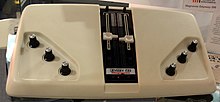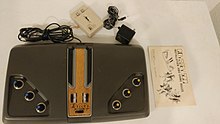Odyssey series
| Odyssey series | |||
|---|---|---|---|
| Manufacturer | Magnavox , Philips | ||
| Type | Series of stationary game consoles | ||
| publication |
|
||
| Storage media | fixed games, game modules | ||
| Controller | Paddles , joysticks | ||
| successor | Philips telephoto game | ||
Magnavox Odyssey is the brand name of Magnavox 's series of game consoles . The series includes the console Magnavox Odyssey (1972) and the successor consoles Magnavox Odyssey 100 (1975) to Magnavox Odyssey 4000 (1977) as well as the console Magnavox Odyssey 2 (1978; US version of the Philips Videopac G7000) . Philips Odyssey is the brand name for the Philips game console series , which includes the game consoles Philips Odyssey 200 (1976) to Philips Odyssey 2100 (1978) and the Philips Videopac G7000 (1978). This article gives an overview of all of these systems.
The Magnavox Odyssey is the first commercial game console and was first released on September 11, 1972 in the United States and later in other countries. The prototype was the Brown Box developed by Ralph H. Baer from 1966 to 1968 . In Germany, the console was first presented by ITT in 1973 at the radio exhibition in Berlin under the name Odyssey . The starting price of the console was 100 in the US dollar . Rotary controls (" paddles ") are attached to the right and left of the controllers .
The Magnavox Odyssey was followed by various successor consoles: Between 1975 and 1977, a total of eight different game consoles were released by Magnavox after the acquisition of Philips in 1974. In 1975 the Magnavox Odyssey 100 appeared and in the following year four more successor consoles called Magnavox Odyssey 200 , Magnavox Odyssey 300 , Magnavox Odyssey 400 and Magnavox Odyssey 500 . The models 2000 , 3000 and 4000 appeared until 1977 . The Model 5000 remained in development and was not released. The models differ only slightly, mostly in the design of the case, the graphics capabilities or the built-in games.
The Magnavox Odyssey 100 was launched in 1975. It is based on four circuits from Texas Instruments and could only play two games ( tennis and hockey ). It is either six C batteries or a 9 volt - AC adapter operated. To the left and right of the housing there are three paddles each, which enable the player to move their player (shown as a bar) horizontally or vertically. The third paddle allows players to control the ball vertically by themselves.
The Magnavox Odyssey 200 was also released in 1975 as a high-end variant of the 100. It has three games of tennis , hockey and smash .
The Magnavox Odyssey 300 was released in 1976. In contrast to the two previous console models, the Odyssey 300 was intended to compete directly with the Coleco Telstar . Like the Telstar, the Odyssey 300 uses the AY-3-8500 chip and was one of the first consoles to use a single IC chip as the focus of their design instead of multiple computer chips or transistor-transistor logic. The Odyssey 300 has the same three games built in as the Odyssey 200, although its gameplay is more similar to Ataris Pong than previous Magnavox games due to the use of the AY-3-8500 . The horizontal controls were missing, the ball angle was automated and the games were controlled with a single switch instead of three. In contrast to the 200, the Odyssey 300 has three levels of difficulty: beginner, intermediate and expert. Also due to the implementation of the AY-3-8500, the 300 introduced a digital dot display on the screen.
The Magnavox Odyssey 400 was released in 1976. It is basically an updated version of the Odyssey 200 with automatic markup and additional on-screen digital rating functions. The console plays the same three games as the Odyssey 200 and has the same three dials for vertical movement, horizontal movement and "English" controls. An additional Texas Instruments chip was used to implement the dot display on the screen. The mechanical point display of the 200 was dispensed with.
The Magnavox Odyssey 500 (model number: 7520) was released in 1976 as Magnavox 'high-end variant of the 300 and 400 models. It is essentially an improved version of the Odyssey 400 with several key enhancements. The Model 500 could output color (the first Odyssey console that could do this) and replaced the paddles displayed on the screen with sprites that represent the athletes of the respective games: a tennis player in tennis, a smash player in ball and a hockey player at hockey. The three players and three playing fields were each selected by separate toggle switches. In addition to the smash, hockey, and tennis games, the Odyssey 500 included a fourth game, soccer, which used the smash player graphics with the hockey field. As with all previous Odyssey devices, power is supplied via a power supply unit or six C-cell batteries.
The Magnavox Odyssey 2000 (model number: BH7510) was released in 1977. It was basically an updated version of the Odyssey 300. Like the 300, the Odyssey 2000 used a single chip design with an AY-3-8500. The Odyssey 2000 is designed for two players and uses a single paddle for each player's game selection instead of the three buttons used by previous Magnavox video game consoles. In addition to the game variants tennis , hockey and squash (" Smash "), the Odyssey 2000 offered a practice variant for the single player mode in the form of the game squash . Points scored during the game were displayed at the top of the screen. Like earlier Odyssey models, the Odyssey 2000 is operated either with six C batteries or an optional power supply unit.
The Magnavox Odyssey 3000 (model number: 7508) was released in 1977. It offers the same game variants as the Odyssey 2000 ( tennis , hockey and smash ). The device is designed for two players, but like the 2000, a solo practice mode for Smash is also available. Additional controls allow players to select automatic or manual serve, ball speed, and ball deflection angle (20 or 40 degrees). With the Odyssey 3000, Magnavox gave up its old case design. The console itself is more angular and less rounded. Two flat buttons are used for the impact and reset functions and the regulator adjustment buttons have been reduced in size. The Odyssey 3000 uses a flat round button to select different games. In contrast to all previous Odyssey consoles, the Odyssey 3000 has removable paddles without fire buttons. The Odyssey 3000 is operated with either six C batteries or an optional power supply unit.
Magnavox concluded their Magnavox Odyssey series with the Magnavox Odyssey 4000 . The console (model number: 7511) was released in 1977. Based on the AY-3-8600 single-chip design, the Odyssey 4000 has a total of six different games (tennis, hockey, soccer, basketball, smash and gridball) and includes a practice mode for solo basketball and smash. As with the Odyssey 3000, the Odyssey 4000 also offers a skill switch for beginners, semi-professionals and professionals. Additional functions are automatic serve and variable ball speeds. In contrast to the Odyssey 3000, the Odyssey 4000 had removable joysticks. The AY-3-8615 chip enabled the Odyssey 4000 to display their games in color instead of black and white graphics. The Odyssey 4000 is powered by an included power supply unit. Joysticks are used for controlling .
The Magnavox Odyssey 5000 should contain two chips, National Semiconductors MM571068 and Sigetics' MUGS-1, whereby the system should play a total of seven games (with variants 24): tennis , hockey , volleyball , basketball , knockout , tank and helicopter . You should be able to play with four players simultaneously or alone against a computer opponent . The model remained in development and was not released.
Philips Odyssey series (1976–1978)
After Magnavox was acquired by Philips in 1974, Philips began making its own versions of the Magnavox Odyssey series consoles. The successor to this game console series is the Philips Tele game series .
Philips Odyssey 200
The Philips Odyssey 200 is largely identical to the Magnavox Odyssey 200. It was released in Europe in 1976 and replaced in 1977 by the Philips Odyssey 2001 .
Philips Odyssey 2001
The Philips Odyssey 2001 is the Philips version of the Magnavox Odyssey 4000 with differences in the games installed and the use of detachable paddles instead of joysticks. Philips Odyssey 2001, released in 1977, is based on the National Semiconductor MM-57105 chip, which contains the games tennis , hockey and squash and supports color and sound from the output device.
Philips Odyssey 2100
The Philips Odyssey 2100 was released in 1978 and has the same housing design as its predecessor in 2001. With the National Semiconductor MM-57186N chip, the system is able to display 6 games, each with several game variants: Wipe-Out (similar to Breakout , 7 Variants), pinball (7 variants), tennis (2 variants), handball (2 variants), ice hockey (2 variants) and football (3 variants).
After Magnavox became a subsidiary of Philips, the Philips Videopac G7000 console appeared in 1978 and was marketed in the USA under the name Magnavox Odyssey 2 ( proper spelling : Magnavox Odyssey² ).
Individual evidence
- ^ Ralph Baer: Recovering the History of the Video Game. Archived from the original on November 2, 2014 ; accessed on December 13, 2015 .
- ^ Rainer Bücken: Tele gadgets. Video Special, December / January 1982/83, p. 24.
- ↑ FOCUS Online: 1972: Magnavox Odyssey. Retrieved May 24, 2019 .
- ↑ a b Wayback Machine. March 8, 2008, accessed February 15, 2020 .
- ↑ a b [1] The Pong Story: Magnavox and the Odyssey system
- ↑ OLD-COMPUTERS.COM: The Museum. Retrieved February 15, 2020 .
- ^ Pong story: Other Magnavox Odyssey systems. Retrieved February 15, 2020 .
- ↑ a b c Kaplan, Deeny, ed. (Winter 1978). "The Video Games". Video (Buyer's Guide) . Reese Communications. 1 (1): 17-30. ISSN 0147-8907.
- ↑ a b c Good Deal Games - Classic Videogame Games ARTICLE - Home Video Game Console History. Retrieved February 15, 2020 .
- ^ Pong story: Philips Odyssey 200. Retrieved February 15, 2020 .
- ↑ Pong-Story: Philips Odyssey 2001. Retrieved February 15, 2020 .
- ^ Pong story: Philips Odyssey 2100. Retrieved February 15, 2020 .











